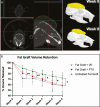Fat Grafts Augmented With Vitamin E Improve Volume Retention and Radiation-Induced Fibrosis
- PMID: 35350074
- PMCID: PMC9342682
- DOI: 10.1093/asj/sjac066
Fat Grafts Augmented With Vitamin E Improve Volume Retention and Radiation-Induced Fibrosis
Abstract
Background: Treatments for radiation-induced fibrosis range from vitamin E (VE) and pentoxifylline (PTX) systemically to deferoxamine and fat grafting locally. Regarding fat grafting, volume retention hinders its long-term functionality and is affected by 2 factors: inflammation and necrosis secondary to hypovascularity.
Objective: The authors aimed to simultaneously improve fat graft retention and radiation-induced fibrosis by integrating VE and PTX into fat grafts locally.
Methods: Forty adult CD-1 nude male mice, 6 weeks old, underwent scalp irradiation and recovered for 4 weeks to allow for development of fibrosis. Mice received 200 μL of donor human fat graft to the scalp. Mice were separated into 4 conditions: no grafting, fat graft without treatment, graft treated with PTX, and graft treated with VE. Fat graft volume retention was monitored in vivo with micro-computed tomography scans at weeks 0, 1, 2, 4, 6, and 8 after grafting. Histological and cytokine analysis of the scalp skin and fat grafts were performed.
Results: VE-treated grafts had significant improvement in dermal thickness and collagen density of overlying skin compared with all other groups. VE decreased 8-isoprostane and increased CD31+ staining compared with the other grafted groups. Cytokine analysis revealed decreased inflammatory and increased angiogenic markers in both the fat graft and overlying skin of the VE group. Fat graft volume retention was significantly improved in the VE group starting at 1 week post grafting.
Conclusions: Radiation-induced fibrosis and fat graft volume retention are both simultaneously improved with local administration of VE.
© The Author(s) 2022. Published by Oxford University Press on behalf of The Aesthetic Society. All rights reserved. For permissions, please e-mail: journals.permissions@oup.com.
Figures




Comment in
-
Response to: Vitamin E Improves Volumetry and Regenerative Effects of Fat Grafting.Aesthet Surg J. 2022 Aug 1;42(8):NP567-NP568. doi: 10.1093/asj/sjac102. Aesthet Surg J. 2022. PMID: 35468179 No abstract available.
-
Vitamin E Improves Volumetry and Regenerative Effects of Fat Grafting.Aesthet Surg J. 2022 Aug 1;42(8):NP565-NP566. doi: 10.1093/asj/sjac089. Aesthet Surg J. 2022. PMID: 35468181 No abstract available.
Similar articles
-
Deferoxamine Preconditioning of Irradiated Tissue Improves Perfusion and Fat Graft Retention.Plast Reconstr Surg. 2018 Mar;141(3):655-665. doi: 10.1097/PRS.0000000000004167. Plast Reconstr Surg. 2018. PMID: 29135894 Free PMC article.
-
Studies in fat grafting: Part III. Fat grafting irradiated tissue--improved skin quality and decreased fat graft retention.Plast Reconstr Surg. 2014 Aug;134(2):249-257. doi: 10.1097/PRS.0000000000000326. Plast Reconstr Surg. 2014. PMID: 25068325 Free PMC article.
-
Angiogenic CD34+CD146+ adipose-derived stromal cells augment recovery of soft tissue after radiotherapy.J Tissue Eng Regen Med. 2021 Dec;15(12):1105-1117. doi: 10.1002/term.3253. Epub 2021 Oct 5. J Tissue Eng Regen Med. 2021. PMID: 34582109 Free PMC article.
-
Fat Graft Retention: Adipose Tissue, Adipose-Derived Stem Cells, and Aging.Plast Reconstr Surg. 2023 Mar 1;151(3):420e-431e. doi: 10.1097/PRS.0000000000009918. Epub 2022 Nov 22. Plast Reconstr Surg. 2023. PMID: 36730531 Review.
-
Improving Fat Graft Survival Using Soluble Molecule Preconditioning.Biomolecules. 2025 Apr 3;15(4):526. doi: 10.3390/biom15040526. Biomolecules. 2025. PMID: 40305256 Free PMC article. Review.
Cited by
-
Prophylactic Decellularized Adipose Matrix Treatment Mitigates Development of Radiation-Induced Cutaneous Fibrosis.Ann Plast Surg. 2025 Jun 1;94(6):688-694. doi: 10.1097/SAP.0000000000004359. Ann Plast Surg. 2025. PMID: 40358965
-
Maximizing the Longevity and Volume Retention of Fat Grafts: Advances in Clinical Practice.Cureus. 2025 Jul 22;17(7):e88493. doi: 10.7759/cureus.88493. eCollection 2025 Jul. Cureus. 2025. PMID: 40851734 Free PMC article. Review.
-
Exploring the mechanisms behind autologous lipotransfer for radiation-induced fibrosis: A systematic review.PLoS One. 2024 Jan 25;19(1):e0292013. doi: 10.1371/journal.pone.0292013. eCollection 2024. PLoS One. 2024. PMID: 38271326 Free PMC article.
-
Deconstructing Fat to Reverse Radiation Induced Soft Tissue Fibrosis.Bioengineering (Basel). 2023 Jun 20;10(6):742. doi: 10.3390/bioengineering10060742. Bioengineering (Basel). 2023. PMID: 37370673 Free PMC article. Review.
-
Adipose-Derived Stromal Cell-Based Therapies for Radiation-Induced Fibrosis.Adv Wound Care (New Rochelle). 2024 May;13(5):235-252. doi: 10.1089/wound.2022.0103. Epub 2022 Dec 9. Adv Wound Care (New Rochelle). 2024. PMID: 36345216 Free PMC article. Review.

